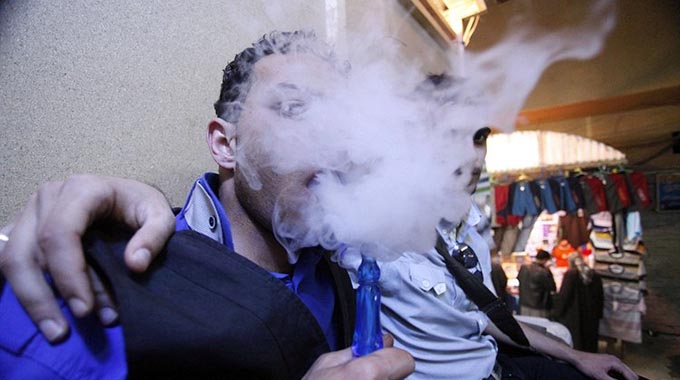Shisha craze: What’s in a puff?

Talent Gore Lifestyle Writer
Shisha smoking has taken Zimbabwe by storm and shisha bars are the in-thing for many city youths who are fast getting hooked to the new craze. Young people seem to be taking it as a show of sophistication and the aromatic smoke of shisha is now common in many of Zimbabwe’s trendy clubs and bars.
The shisha, or hookah, an instrument used for smoking tobacco, with the smoke passing through a water basin, has for centuries been a part of various cultures, especially in Asia, the Middle East and Africa.
The craze in Zimbabwe originated in Harare and has spread to other cities across the country.
From the lavish settings of Pablo’z VIP Lounge in Borrowdale, to the outdoors of KwaFatso in Glen Norah, shisha is the in-thing.
In major cities like Harare and Bulawayo, there have opened up shisha bars, and these places draw scores of young people on weekends and even week nights.
Many people who do not smoke cigarettes have hopped onto the shisha bandwagon, with the assumption being that it is a “safer” habit.
For around US$5 or 20 RTGS dollars, a hookah is hired and shared among friends. Those who prefer their personal hookahs part with between US$10 and US$20 depending on the size, brand and sophistication.
But shisha is not “safer” as many have been made to believe. It comes with health risks associated with exposure to toxic chemicals and infectious diseases that are caused by sharing pipes. Smokers can be exposed to oral herpes, tuberculosis, hepatitis and influenza.
Leon Tawanda Mupanemunda, who sells shisha and the flavours, said he prefers the shisha as it does not leave him with a stench of cigarette smoke.
“Shisha is a lifestyle. It’s basically a social accessory. Some people smoke it alone in the comfort of their homes but mostly it’s there to keep people in one place and pass time,” he said.
“The addictive part depends on what you are smoking in the shisha. I have been smoking it for five years or so but I am not addicted to it
“Shisha is associated with fun and nightlife. People can be easily attracted when it comes to things they see everyone else doing everywhere in the world.”
Mupanemunda said many people want to try shisha.
“Smoking shisha is the trend and everybody wants to try it out. It is not harsh like cigarettes and the flavours make it pleasant and that is why most people like it,” he said.
“When people go out clubbing, it becomes a common thing to try it out because everyone else will be enjoying blowing out the smoke and passing the hookah pipe to the next person.
“It also comes at a price in the club and so it also looks cool to be blowing some smoke and getting the vibe.
“With the numerous designs they come in, they are just too attractive to walk past without noticing.”
He added: “There are health hazards, yes, because smoking shisha exposes you to tobacco smoke as the molasses used in the hookah are basically flavoured tobacco. Other people look for alternatives to tobacco however.
“Smoking shisha will not get a person high (unless they are using other things like marijuana), a person feels a little buzzed and light headed, and they will definitely feel relaxed.”
It is so fashionable nowadays and youngsters do not seem to be concerned at all about the health implications of getting literally hooked to the hookah pipe.
“The fruit and herb flavourings make the shisha seem gentler, and some think that the negative effects are reduced because it is passed through water,” said Mupanemunda.
Those who hire out hookahs say they sanitise the pipes regularly, while some customers request they insulate the tips with foil.
Shisha users are also at risk of the same problems that affect cigarette smokers: heart disease, cancer, respiratory diseases and problems during pregnancy.
Most containers of flavoured tobacco have warnings on how smoking damages the lungs and that the smoke can also harm those nearby.
Oddly, some establishments which do not allow normal cigarette smoking indoors have okayed shisha.
The tobacco in hookahs is exposed to high heat from burning charcoal, and the smoke is as toxic as cigarette smoke.
Because of the way a hookah is used, smokers may absorb more of the toxic substances also found in cigarette smoke than cigarette smokers do.
Research by the World Health Organisation highlights that the volume of smoke inhaled in an hour-long shisha session is equivalent to smoking between 100 and 200 cigarettes.
However, there are some tobacco-free versions of the shisha, which use mixed flavoured herbs and all sorts of concoctions. These are heavily advertised to be harm-free and better than the tobacco version of the hookah.
These sweetened and flavoured non-tobacco products are sold for use in hookahs and are touted as healthy.
Labels and advertisements for these products often claim that users can enjoy the same taste without the harmful effects of tobacco









Comments